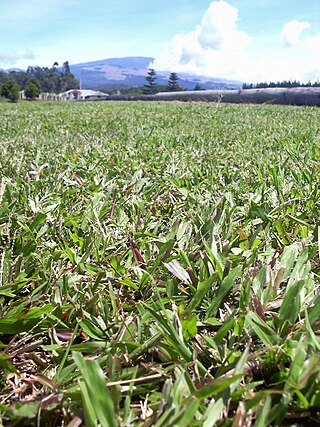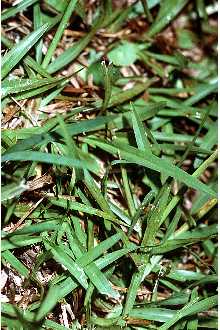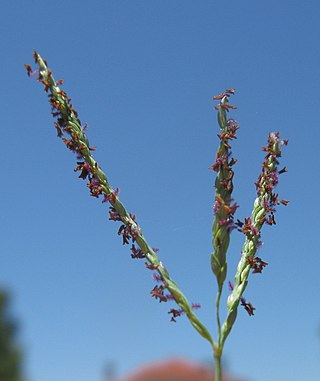
The peanut, also known as the groundnut, goober (US), goober pea, pindar (US) or monkey nut (UK), is a legume crop grown mainly for its edible seeds. It is widely grown in the tropics and subtropics by small and large commercial producers, both as grain legume and as an oil crop. Atypically among legumes, peanut pods develop underground leading botanist Carl Linnaeus to name peanuts hypogaea, which means "under the earth".

Arachis is a genus of about 70 species of annual and perennial flowering plants in the family (Fabaceae), native to South America, and was recently assigned to the informal monophyletic Pterocarpus clade of the Dalbergieae. At least one species, the peanut, is a major food crop species of global importance; some of the other species are cultivated for food to a small extent in South America. Other species such as A. pintoi are cultivated worldwide as forage and soil conditioner plants, with the leaves providing high-protein feed for grazing livestock and a nitrogen source in agroforestry and permaculture systems.

Forage is a plant material eaten by grazing livestock. Historically, the term forage has meant only plants eaten by the animals directly as pasture, crop residue, or immature cereal crops, but it is also used more loosely to include similar plants cut for fodder and carried to the animals, especially as hay or silage.

Legumes are plants in the family Fabaceae, or the fruit or seeds of such plants. When used as a dry grain for human consumption, the seeds are also called pulses. Legumes are grown agriculturally, primarily for human consumption, but also as livestock forage and silage, and as soil-enhancing green manure. Well-known legumes include beans, chickpeas, peanuts, lentils, lupins, mesquite, carob, tamarind, alfalfa, and clover. Legumes produce a botanically unique type of fruit – a simple dry fruit that develops from a simple carpel and usually dehisces on two sides.

Paspalum is a genus of plants in the grass family.

Axonopus compressus is a species of grass. It is often used as a permanent pasture, groundcover, and turf in moist, low fertility soils, particularly in shaded situations. It is generally too low-growing to be useful in cut-and-carry systems or for fodder conservation.

Arachis repens is a species in the family Fabaceae native to Brazil. This plant is often used as a forage and ornamental plant.
Arachis villosulicarpa is a perennial peanut species, which is cultivated by indigenous people in Mato Grosso, a state of Brazil. Its wild progenitor is thought to be Arachis pietrarellii. Although it is related to the common peanut, Arachis hypogaea, it was separately domesticated: A. villosulicarpa is diploid, whereas A. hypogaea is tetraploid.

Peanut mottle virus(PeMoV) is a pathogenic plant virus of the family Potyviridae. As with other members of this virus family, PeMoV is a flexuous filamentous virus with particles 740–750 nm long. It is transmitted by several species of aphids and by mechanical inoculation. It was first given its name in 1965 when it was isolated from peanuts (Arachis hypogaea) in Georgia, United States. The virus was found to be seed transmitted in its host.
Peanut stunt virus (PSV) is a plant pathogenic virus in the family Bromoviridae. It is a member of the genus Cucumovirus. The members of this genus are positive-stranded RNA viruses with a multipartite genome. The virus particles have an isometric or spherical shape.

Axonopus is a genus of plants in the grass family, known generally as carpet grass. They are native primarily to the tropical and subtropical regions of the Americas with one species in tropical Africa and another on Easter Island. They are sometimes rhizomatous and many are tolerant of periodic submersion.

Tussock grasses or bunch grasses are a group of grass species in the family Poaceae. They usually grow as singular plants in clumps, tufts, hummocks, or bunches, rather than forming a sod or lawn, in meadows, grasslands, and prairies. As perennial plants, most species live more than one season. Tussock grasses are often found as forage in pastures and ornamental grasses in gardens.

Stylosanthes is a genus of flowering plants in the legume family Fabaceae and contains numerous highly important pasture and forage species. It was recently assigned to the informal monophyletic Pterocarpus clade of the Dalbergieae. The common name pencilflower is sometimes used for plants in this genus.

Arachis pintoi, the Pinto peanut, is a forage plant native to Cerrado vegetation in Brazil. It is native to the valleys of the upper São Francisco and the Jequitinhonha rivers of Minas Gerais. It has been named after the Brazilian botanist Geraldo Pinto, who first collected the plant at the locality of Boca do Córrego, município de Belmonte in 1954 and suggested its potential as a forage. The species has been first described by A. Krapovickas and W. Gregory in 1994.
Bela "Bert" Grof was a Hungarian-born Australian agricultural researcher with contributions to grassland and forage research in the tropics.

Paspalum plicatulum is a species of grass known by the common name brownseed paspalum. In Brazil its names include capim coquerinho, felpudo and pasto-negro. It is called zong zi que bai in Chinese and herbe à cheval in French. In South America its names include camalote, gamelotillo, and hierba de cepa. It is native to the Americas, where it occurs in the southeastern United States, Mexico, the Caribbean, and parts of South America.

Urochloa brizantha is a species of grass known by the common name palisade grass. It is often used as a forage for livestock. Other common names include palisade signal grass, bread grass, Mauritius grass, Surinam grass, large-seeded millet grass, big ashama, Ceylon sheep grass, and St. Lucia grass.

Digitaria didactyla is a species of grass known by the common names blue couch, Queensland blue couch, blue serangoon grass, green serangoon grass, blue stargrass, and petit gazon. It is native to Mauritius, Réunion, parts of mainland Africa, and Madagascar. It has been introduced widely outside its native range, mainly for use as a pasture and turf grass. It has naturalized in some regions.

Alysicarpus vaginalis is a species of flowering plant in the legume family, Fabaceae. It is native to parts of Africa and Asia, and it has been introduced to other continents, such as Australia and the Americas. It is cultivated as a fodder for livestock, for erosion control, and as a green manure. Common names include alyce clover, buffalo clover, buffalo-bur, one-leaf clover, and white moneywort.
















